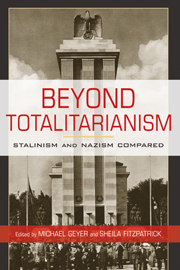2 - The Political (Dis)Orders of Stalinism and National Socialism
Published online by Cambridge University Press: 05 June 2012
Summary
The onset of perestroika and the collapse of the Soviet system promised to redress a long-standing imbalance in the study of Stalinism and Nazism. Previous restrictions on archival access and on the openness of official Soviet discourse had meant that the corpus of credible academic research on Stalinism had lagged behind the equivalent scholarship on the Nazi system. The opening of the archives and the emergence of a meticulous and even-handed post-Soviet historical scholarship have done much to set this imbalance to rights. Among the most striking revelations of the last fifteen years has been the unearthing of a large body of evidence incriminating the Stalinist leadership in successive waves of violence against their own population. Detailed revelations on Stalinist “ethnic cleansing,” on the elaborate network of slave labor camps across the country, and on Stalin's own blood-stained involvement in the running of a fiercely coercive state have tended to accentuate the strong family resemblances that bound the two systems and set them apart from the other personal dictatorships of interwar Europe. While other regimes may have had dictators and one-party states geared toward mass mobilization, none “repressed, enslaved, and then killed millions of their subjects,” as Hitler's Germany and Stalin's Soviet Union did. “The two regimes belong together,” the sociologist Michael Mann was to write in the mid-1990s. “It is only a question of finding the right family name.”
- Type
- Chapter
- Information
- Beyond TotalitarianismStalinism and Nazism Compared, pp. 41 - 86Publisher: Cambridge University PressPrint publication year: 2008
References
- 3
- Cited by



